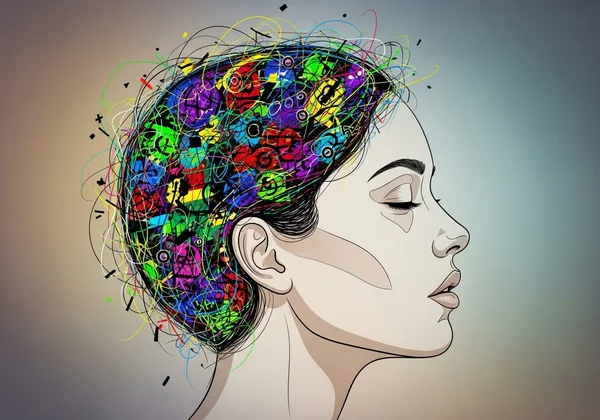ADHD Test for Women: Uncovering Hidden Symptoms
Do you ever feel like you're running on a hamster wheel, constantly overwhelmed and exhausted, but chalk it up to stress or anxiety? For many women, the classic image of ADHD—a hyperactive young boy—doesn't resonate. If you've ever wondered, Do I have ADHD?, but dismissed the thought because you're not bouncing off the walls, you are not alone. This is a common experience, and understanding the unique presentation of an ADHD test for women is the first step toward clarity.
This article explores the subtle, often-missed signs of ADHD in women and guides you toward understanding your own mind better. These insights can be the beginning of a journey to self-discovery and support. If what you read resonates with you, a great starting point is a confidential online ADHD test to explore these traits further.

Uncovering the Hidden ADHD Symptoms in Women
ADHD in women often looks very different from the stereotype. It's less about outward hyperactivity and more about internal chaos. These symptoms can be easily misdiagnosed or dismissed as personality flaws, leading to years of confusion and self-doubt. Let's uncover some of these hidden signs.
Beyond Hyperactivity: What Internalized Symptoms Look Like
For many women, hyperactivity isn't physical; it's mental. This mental restlessness can feel like having a browser with 50 tabs open in your brain, all playing different music at once. You might not be running around the room, but your mind is racing from one thought to another without a break.
This can manifest as:
- An inability to relax, even during quiet moments.
- A constant stream of creative ideas, but difficulty focusing on just one.
- Overthinking social interactions, replaying conversations for hours.
- Difficulty falling asleep because your brain simply won't switch off.
This internalized hyperactivity is exhausting and can contribute significantly to feelings of anxiety and being perpetually overwhelmed. It's a core component of what an ADHD screening looks for beyond physical movement.

The Overwhelm of Emotional Dysregulation
One of the most challenging and misunderstood aspects of ADHD in women is difficulty with emotional regulation. You might experience emotions with incredible intensity, shifting from joy to frustration to sadness in a short period. This isn't a character flaw; it's a difference in brain wiring.
This trait is often linked to something called Rejection Sensitivity Dysphoria (RSD), a term used to describe an extreme emotional sensitivity to perceived criticism or rejection. You might experience ADHD mood swings that feel disproportionate to the situation, leaving you and others confused. This can look like being easily hurt by comments, having an intense fear of failure, or engaging in people-pleasing to avoid disapproval.
The Exhausting Art of 'Masking' Your Struggles
From a young age, girls are often socialized to be agreeable, organized, and quiet. When their brains don't naturally work that way, they learn to "mask." ADHD masking is the subconscious process of hiding your symptoms to fit in and meet societal expectations. It's an exhausting, lifelong performance.
Masking can involve:
- Forcing yourself to maintain eye contact in conversations, even when it's uncomfortable.
- Developing complex organizational systems (like multiple planners and alarms) out of a desperate need to not forget things, which often leads to burnout.
- Suppressing impulsive thoughts or behaviors, leading to a build-up of internal tension.
- Mirroring the social behaviors of others to appear "normal."
Imagine a project manager who never misses a deadline, but her apartment is in chaos and she spends every Sunday recovering from the sheer effort of appearing 'put-together' all week. This is a classic example of high-functioning masking. While masking can help women succeed academically or professionally, it comes at a huge cost to their mental health, often leading to anxiety, depression, and a profound sense of not knowing who they truly are. Taking an ADHD self-assessment can be a private way to see behind the mask.

The Inattentive Traits: Daydreaming, Disorganization, and 'Brain Fog'
The inattentive side of ADHD is where many women see themselves most clearly. These symptoms are often dismissed as being "ditzy," "lazy," or "a dreamer." In reality, they are legitimate neurological challenges.
Common inattentive traits include:
- Zoning out: Losing focus during conversations or meetings, even when you're trying your best to pay attention.
- Chronic Disorganization: A messy car, a cluttered desk, or piles of laundry, despite your best efforts to tidy up.
- Time Blindness: Consistently underestimating how long tasks will take, leading to chronic lateness.
- Brain Fog: A feeling of mental cloudiness that makes it hard to think clearly or retrieve information.
If you find yourself constantly misplacing your keys, phone, or wallet, or if starting and finishing projects feels like climbing a mountain, you may be experiencing the inattentive side of ADHD. An inattentive ADHD test could help you identify these specific patterns.

Why is Adult ADHD in Women So Often Undiagnosed?
Millions of women live with undiagnosed ADHD, facing daily struggles without knowing the root cause. This diagnostic gap exists for several complex reasons, rooted in historical biases and a lack of understanding of how ADHD presents differently across genders. Recognizing these factors is crucial for advocacy and self-compassion.
The Impact of Social Expectations and Gender Bias
Historically, ADHD research focused almost exclusively on hyperactive young boys. The diagnostic criteria were built around this model, completely overlooking the internalized and inattentive symptoms more common in girls. As a result, girls with ADHD were not disruptive in the classroom; they were often the quiet daydreamers in the back row.
Teachers and parents were less likely to flag these girls for evaluation. This gender bias in diagnosis has had a lasting impact, as these girls grew into women who believed their struggles with focus, organization, and emotional regulation were personal failings rather than symptoms of a neurological condition.
How Hormonal Changes Can Affect ADHD Symptoms
A critical and often overlooked factor is the interplay between hormones and ADHD. Estrogen plays a key role in regulating neurotransmitters like dopamine, which are central to focus and executive function. When estrogen levels fluctuate, ADHD symptoms can become significantly more pronounced.
Many women notice their symptoms worsen during specific points in their menstrual cycle, pregnancy, perimenopause, and menopause. This hormonal influence can create a confusing pattern of "good brain days" and "bad brain days," making it even harder to recognize the underlying consistency of ADHD. This is a vital piece of the puzzle that a specialized ADHD test for women implicitly considers.
Overlap with Anxiety and Depression
Living with undiagnosed ADHD is incredibly stressful. The constant struggle to keep up, the feeling of never reaching your potential, and the shame from perceived failures often lead to co-occurring mental health conditions like anxiety and depression.
Unfortunately, when a woman seeks help, a clinician may diagnose and treat the anxiety or depression without recognizing ADHD as the underlying driver. While treating the secondary condition is important, it's like mopping up a flooded floor without turning off the overflowing tap. Without addressing the root ADHD, the cycle of struggle often continues. If this sounds familiar, it may be time to get a free ADHD test.
Your First Step Towards Clarity: Taking an ADHD Test for Women
Recognizing yourself in the descriptions above can be both overwhelming and validating. It’s a sign that you’re not lazy, broken, or flawed—your brain may just be wired differently. Understanding this is the first, most powerful step toward creating a life that works with your brain, not against it. ADHD in women is real, valid, and presents in unique ways that deserve recognition.
The journey to clarity begins with a single step: taking an ADHD test. If you're ready to explore these possibilities in a safe and confidential way, we invite you to take the free ADHD test on our homepage. Our science-informed screening tool is designed for adults and provides a personalized, AI-driven report to help you understand your unique traits. This report can be a valuable starting point for a conversation with a healthcare professional.
Frequently Asked Questions About ADHD in Women
What are the main symptoms of ADHD in women?
While symptoms vary, the main signs in women are often internalized. They include mental restlessness (a racing mind), emotional dysregulation (intense feelings and mood swings), a tendency to mask or hide struggles, and inattentive traits like disorganization, daydreaming, and chronic overwhelm.
Can you test for ADHD online?
Yes, you can use an online screening tool as a first step. An online ADHD test like ours is a reliable screening method designed to identify potential ADHD traits based on established criteria. It is not a formal diagnosis but provides a personalized report that can help you decide whether to seek a professional evaluation.
How is ADHD tested and diagnosed in adults?
A formal diagnosis for adult ADHD testing is conducted by a qualified healthcare professional, such as a psychiatrist, psychologist, or neurologist. The process typically involves a detailed clinical interview about your symptoms (both current and in childhood), self-report questionnaires, and sometimes interviews with a family member. It’s a comprehensive process to ensure an accurate diagnosis.
What feels like ADHD in women but isn't?
Several conditions can mimic ADHD symptoms. These include anxiety disorders, depression, burnout from chronic stress, thyroid conditions, and complex trauma (C-PTSD). Because of this overlap, it's crucial to use a screening tool as a starting point and follow up with a professional for a definitive diagnosis. Taking an initial ADHD screening test can help organize your thoughts before that conversation.